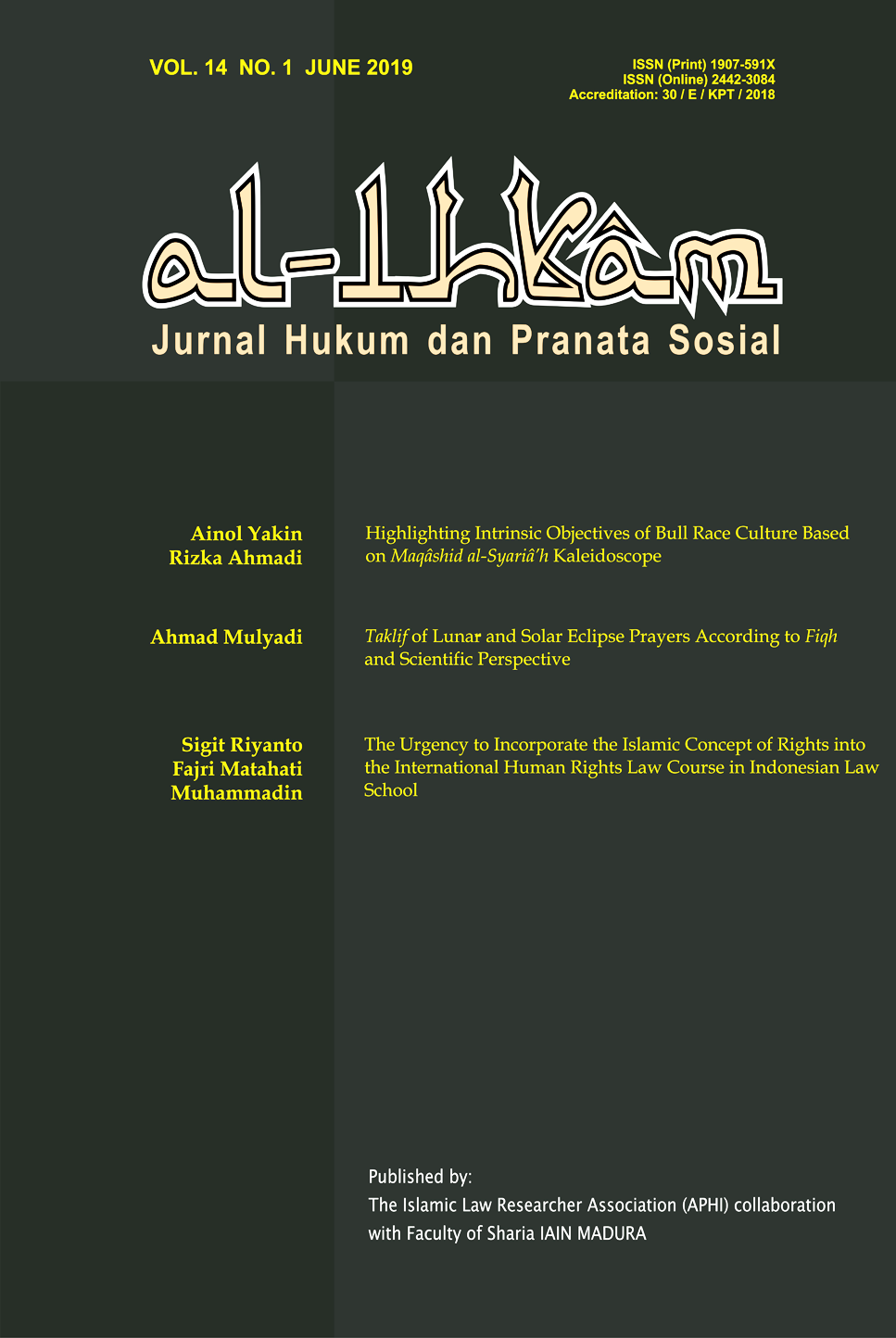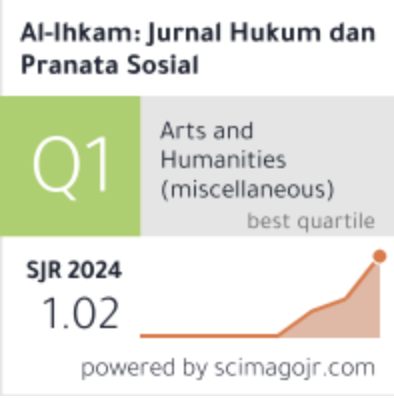Specific Treatment of Elderly Pilgrims on Hajj According to the Hadith ; The Approach of Mukhtalif Ahadis
 Abstract views: 589
,
Abstract views: 589
,
 PDF downloads: 440
PDF downloads: 440
Abstract
Most of Indonesian hajj pilgrims are elderly due to approximately 23 years waiting period. This paper aims to elaborate specific treatment of elderly pilgrims according to the hadith. Some hadith imply indirect prohibition to perform hajj by themselves while others still motivate the hajj in a hard condition. Using the approach of mukhtalif ahâdits, this paper seeks to answer three questions. First, how did hadith say about specific treatment of elderly hajj pilgrims. Second, how to deal with two groups of hadith which slightly look different. Third, how is proper contextual interpretation on the hadith in Indonesian contemporary life. The data compilation is through literature reviews and interviews. Then, the two groups of hadith are compromised using a method called al-jam’u wa al-tawfiq. It truns out that the first hadith applies for those who can’t really perform the hajj while another is for those with physical problems but could still stand for hajj using some facilities and policies. Those all lead to an inevitable need for a special hajj manasik for elderly so they could perform the hajj with better preparation. (Dengan waktu tunggu keberangkatan kurang lebih 23 tahun, sebagian besar jama’ah haji Indonesia adalah lansia. Penelitian ini mendiskusikan pandangan hadist soal perlakuan khusus terhadap jama’ah lansia. Beberapa hadist menyiratkan imbauan untuk tidak melaksanakan haji secara langsung, sedang beberapa lain tetap memotivasi pelaksanaan haji dalam keadaan sulit sekalipun. Dengan pendekatan mukhtalif ahâdits, penelitian ini fokus menjawab tiga persoalan. Pertama, bagaimana pandangan hadist terhadap jamaah lansia. Kedua, bagaimana mengompromikan dua (kelompok) hadist yang sekilas tampak berbeda. Ketiga, bagaimana interpretasi kontekstual hadist-hadist tersebut dalam konteks Indonesia dewasa ini. Data penelitian didapat melalui penelusuran pustaka dan wawancara. Dua kelompok hadist kemudian dikompromikan dengan metode al-jam’u wa al-tawfiq. Hasilnya menunjukkan bahwa hadist pertama berlaku bagi jama’ah yang benar-benar tidak bisa melaksanakan haji, sedang yang kedua adalah bagi mereka dengan kemampuan fisik yang minim namun masih memanfaatkan fasilitas dan kebijakan yang ada. Dari situ, adanya sebuah manasik (kelas haji) khusus lansia di Indonesia menjadi keniscayaan agar jama’ah lansia dapat semakin maksimal memersiapkan dan melaksanakan haji)
Downloads
References
A. Alzeer (et al), “Tuberculosis is the Commonest Cause of Pneumonia Requiring Hospitalization During Hajj (Pilgrim to Makkh),” Journal of Infection, Vol. 36, issue 3 (May 1998).
Al Munawar, Said Agil Husin and Abdul Halim. Fikih Haji; Menuntun Jama’ah Mencapai Haji Mabrur. Jakarta: Ciputat Press, 2003.
Al-Adlabi, Shalahuddin bin Ahmad. Menalar Sabda Nabi; Menerapkan Metode Kritik Matan dalam Studi Hadist transl. Ita Qonita. Yogyakarta: Bintang Pustaka Abadi. 2010.
Al-Asqalani, Ahmad Ibnu Ali Ibnu Hajar. Fathul Bari vol. 3. Kairo: Al-Maktabah Al-Tawfiqiyyah, 2008.
Al-Qudhat, Syaraf. ‘Ilmu Mukhtalif Ahadis: Ushuluhu wa Qawa’iduhu. Amman: Al-Jami’ah Al-Urduniyah, 2001.
Alzeer, Abdulaziz H. “Respiratory Tract Infection during Hajj”, Annals of Thoracic Medicine, Vol. 4 (2) (Apr-Jun 2009).
An-Nawawi, Yahya bin Syarif Abu Zakariyya. Syarh Nawawi ‘ala Muslim. sl: Darul Khair, 1996.
Baqi, Muhammad Fu’ad Abdul. Mutiara Hadits Shahih Bukhari-Muslim Al-Lu’lu’ wal Marjan transl. Salim Bahreisy. Surabaya: Bina Ilmu, 2005.
Bukhari, Imam. Shahih Bukhari vol. 1. Istanbul: Darul Fikr, s.a.
Elsayed, Khaled Abdelhay and Kamaruzaman Yusoff, “The Implication of Peace Treaties in Disseminating Da’wah Islamiyah (the Islamic Call) among non-Muslims: A Special Reference to Hudaibiya Treaty”, Australian Journal of Basic and Applied Science, Vol. 6 (7), (2012).
Ferrari, Silvio and Andrea Benzo (ed), Between Cultural Diversity and Common Heritage: Legal and Religious Perspectives on the Sacred Places of the Mediterranean. London: Routledge, 2014.
Hitti, Phillip K. History of the Arabs. transl. Cecep Lukman Yasin & Dedi Slamet Riyadi. Jakarta: Serambi, 2006.
Ibrahim, Mahmoud (et al), “Recommendations for Management of Diabetes and Its Complications during Hajj (Muslim Pilgrimage)”, Clinical Medicine, Vol. 11 (3) (June, 2011).
M. Julius St. Manajemen Perjalanan Haji Reguler. Malang: UB Press. 2011.
Mandourah, Yasser (et al), “Clinical and Temporal Patterns of Severe Pneumonia Causing Critical Illness during Hajj”, BMC Infectious Disease, Vol. 12 (117), (2012).
Mandzur, Ibnu. Lisan Al-Arab. Beirut: Dar Shadr, s.a.
Porter, Venetia and Liana Saif. The Hajj: Collected Essays. Hockley: British Museum, 2013.
Rashid, Harunor (et al), “The Potential for Pneumococcal Vaccination in Hajj Pilgrims: Expert Opinion” Travel Medicine and Infectious Disease, vol. 11 (5) (June 2013).
Safri, Edi. “Al-Imam Al-Syafi’i; Metode Penyelesaian Hadist-Hadist Mukhtalif”, dissertation, IAIN Jakarta, 1990.
Shari’ati, Ali. Hajj; The Pilgrimage. s.l: Free Islamic Literature, 1980.
Shihab, M. Quraish. Membaca Sirah Nabi Muhammad SAW dalam Sorotan Al-Qur’an dan Hadist-hadist Shahih. Jakarta: Lentera Hati, 2012.
Solikhin, Muhammad. Keajaiban Haji dan Umrah; Mengungkap Kedahsyatan Pesona Ka’bah dan Tanah Suci. Jakarta: Erlangga, 2013.
Syafi’ie, Imam. Al-Risalah. Beirut: Dar al-Kutub al-Ilmiyyah. s.a
Tariq A. Madani (et al), “Causes of Hospitalization of Pilgrims during the Hajj Period of the Islamic Year 1423 (2003),” in Ann Saudi Med, Vol. 26(5), (September-October 2006).
Thabrani, Akhmad Siddiq. Di Tengah Pusaran Ka’bah; Sejarah, Keajaiban, Mitos dan Mistik. Depok: Keira Publishing, 2014.
Tirmdzi, Imam. Al-Jami’ Al-Sahih Sunan Tirmidzi vol. 3. Lebanon: Dar Kutub Al-Ilmiyyah. 2011.
Wahyudi, Arif. “Kontroversi Hadist-hadist Menangisi Mayit,” Al-Ihkam, vol 9, numb. 1 (June, 2014).
Internet Websites
Diaz, “Musim Haji 2016 Kemenag akan Uji Cob Gelang GPS”, https://haji.kemenag.go.id/v3/content/musim-haji-2016-kemenag-akan-uji-coba-gelang-gps (Accessed on August 18, 2018).
http://hadithportal.com/hadith-sharh-928-21662&book=3
http://library.islamweb.net/newlibrary/display_book.php?idfrom=3937&idto=3939&bk_no=53&ID=586
Redaksi, “60 Jama’ah Haji Indonesia 2018 Didominasi Lansia”, in ”https://haji.okezone.com/read/2018/04/25/398/1891271/60-jamaah-haji-indonesia-2018-didominasi-lansia.
Redaksi, “Kemenag Yogyakarta Siap Buka Kelas Bimbel Manasik Berbasis Lansia dan Disabilitas”, in https://haji.kemenag.go.id/v3/content/kemenag-yogyakarta-siap-buka-kelas-bimbel-manasik-berbasis-lansia-dan-disabilitas
Redaksi, “Pemerintah Pertimbangkan Rancangan Kloter Khusus Lansia”, https://haji.kemenag.go.id/v3/node/1082
Redaksi, “Pertanyaan yang Paling Sering Ditanyakan,” in https://haji.kemenag.go.id/v3/ragam/faq-haji?body_value=&page=1
Redaksi, “PPIH Siapkan Transportasi Khusus Jemaah Haji”, in https://haji.kemenag.go.id/v3/content/ppih-siapkan-transportasi-khusus-jemaah-haji-lansia.
Redaksi, “Tawaf Jamaah Pakai Kursi Roda Dijadwalkan Malam Hari,” in https://haji.kemenag.go.id/v3/node/1399 .
Subarkah, Muhammad. “Layanan Kursi Roda bagi Jama’ah Haji Disiapkan”, in https://www.republika.co.id/berita/jurnal-haji/berita-jurnal-haji/18/06/08/pa0jm5385-layanan-kursi-roda-bagi-jamaah-haji-disiapkan
Interview
Interview with Mr. Halik Yadi, an experienced guide who served as an officer of TPHI (Tim Pemandu Haji Indonesia, Indonesian Hajj Guide Team) at 1998 and 2006 and the chief of pilgrim group or as know as ketua rombongan at 2016. The interview in his office at IAIN Madura, August 05, 2018.
Interview with Mr. Afandi, the former chair division of hajj, The Ministry of Religious Affair, Pamekasan district, in his office, Jl. Brawijaya, Pamekasan, on August 27, 2018, 15.00-16.00.
Interview with Ayis Mukholik, a member of non-flight team of Indonesian hajj 2018 via WhatsApp messenger, May 29, 2019.
In order to be accepted and published by Al-Ihkam: Jurnal Hukum dan Pranata Sosial, author(s) submitting the article manuscript should complete all the review stages. By submitting the manuscript, the author(s) agreed to the following terms:
- The copyright of received articles shall be assigned to Al-Ihkam: Jurnal Hukum dan Pranata Sosial as the publisher of the journal. The intended copyright includes the right to publish articles in various forms (including reprints). Al-Ihkam: Jurnal Hukum dan Pranata Sosial maintain the publishing rights to the published articles.
- Authors are permitted to disseminate published articles by sharing the link/DOI of the article at Al-Ihkam: Jurnal Hukum dan Pranata Sosial. Authors are allowed to use their articles for any legal purposes deemed necessary without written permission from Al-Ihkam: Jurnal Hukum dan Pranata Sosial with an acknowledgment of initial publication to this journal.
- Users/public use of this website will be licensed to CC-BY-SA.



.png)
_1.png)


_page-00011.jpg)


